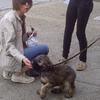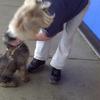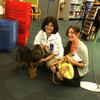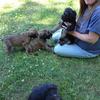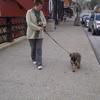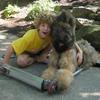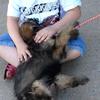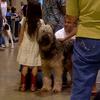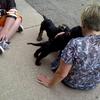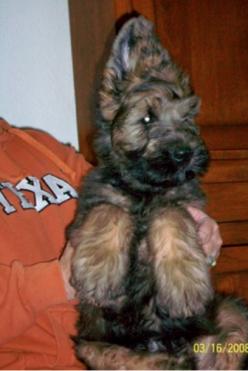Socialization
Briard Socialization by Terry Miller
But what the heck IS socialization? Socialization is the exposure to constantly novel situations and stimuli. That means frequent change and intermittent challenges to routine. That means an onslaught of interaction with strangers in new and ever changing locations with new and ever changing sights, sounds and textures. Socialization can happen any time in life but it is most effective during the critical periods of puppy development. These are the times when the foundation decisions are put in place during the most formative time in a canine’s life. Birth to 16 weeks is the critical period but any dog can benefit from socialization even later. Its greatest importance happens during the critical periods since the seeds of adult decisions and outlook are planted then. Socialization is always important for all dogs but the herding/ working/guarding breeds have a particular need to help them fit into societal expectations in urban environments. The Briard takes its place among breeds that are typically content to not know anyone or anything new, not let anyone in or out of the house and would be happy to exist in an environment with a limited social circle of familiar family friends...and no one else. We do sometimes see the less typical members of the breed who are naturally extroverted and outwardly socially indiscriminant, but the average is more cautiously judgmental than that. The role of socialization is to blunt the naturally discriminant behavior and condition more outgoing social behavior.
There is no such a thing as too much socialization. There is no such thing as taking your dog too many places or exposing him to too many changes. I suggest that in the life of the average Briard puppy up through 1 year, the dog meet and greet and be touched by at least 50 new people a month in minimally 20 new places/situations. That includes flea markets, shopping centers, farmers’ markets, the vet, dog classes, dog parks*, Home Depot, the dry cleaners, video store, outside dining...you get the drift. Classes are a wonderfully concentrated way of accomplishing much of this however, the situations/ places need to be new to be most effective.
* I am not a proponent of dog parks. You become a sitting duck prey to some of the idiots who mismanage badly behaved dogs. It puts you and your dog at risk.
Click to enlarge images.
Below are some articles on socialization of our Briards.
Briard Temperament BEC Dew Claw 4/2013
By Terry Miller in Briard Club of America national magazine The Dew Claw
The Briard temperament is a surprise to many at first contact with the breed. They are intensely affectionate to their loved ones, devoted to a fault and exclusive in their loyalty. Most Briards have strong opinions and are fairly assertive about their needs and expectations, requiring a clear and constant leader with unwaivering boundaries. As expected when categorized as a herding/ guarding breed, the Briard is selective, discriminant, aware, reserved
with strangers, job oriented and high drive . The breed is high maintenance by their basic grooming needs as any coated dog, but even higher maintenance because of their socialization needs. This is a breed whose default setting is to know and love the familiar-their family, their friends...and no one and nothing else. The needs of the average urban lifestyle demand a more extroverted and social animal, making the socializing process a necessity to developing a dog who is a good citizen in the world. Good Briard raising practices include constant exposure out of the home and away from the familiar surroundings to create contact with constantly changing situations and new people. This is a process which needs constant reinforcement for the first year or more of a Briard's life.
Briard social behavior is fraught with potential for wonderfully positive things and equally negative things. Briards are warm kind and fuzzy therapy dogs for the needs of hospitalized and shut in individuals. The breed’s natural touchy/feely tendencies provide soothing tactile therapy to those in need of a good dose of affection.
However, the flip side can be coupling a dog with a discriminant nature and high prey drive, and exposing that
Briard Temperament BEC Dew Claw 4/2013 by Terry Miller in Briard Club of America national magazine The Dew Claw
individual to dog parks or doggy day care. The recipe for a bad reputation is waiting to happen. Add in a dose of an owner or handler not paying attention or exercising clear cut impulse control rules...voila...dog fight, or dog chase...or bullying...or recipient of bullying reacting extremly emotional....sometimes igniting the prey reation of the Briard even more.
Here is where the subjects of dog parks and doggy day care enter the picture. A relatively new subject for dog owners, but of realistic concerns to Briard owners in keeping their Briards safe and not adding to the statistics of BBB, “Bad Briard Behavior”. Many Briard owners recognize that offering their Briard the chance to run wildly in a dog park with others, can often ad a spark to the already electric social dynamic of multiple strange canines gathering to interact while their owners pay half attention. It becomes a bad habit to introduce and a bad precedent to set.
Likewise in doggy day care settings, if rigidly clear management is not applied and half attention paid...BBB, “bad Briard behavior” can rear its ugly head. The more sophisticated and educated of dog people avoid such dog/ dog/dog settings to limit exposure to bad behavior learning opportunities and the liability of the blame.
In their best form, the Briard is a remarkably easy and quiet house dog with a keen and developed sense of humor all evident from an early age. They are smart and engaged, busy and involved when appropriate and quietly content to lay in a heap on their loved one's feet for the rest of their day.
Showsight Magazine by Terry Miller. December 2012.
Briards and Who They Are
The Briard temperament is a surprise to many at first contact with the breed. They are intensely affectionate to their loved ones, devoted to a fault and exclusive in their loyalty. Most Briards have strong opinions and are fairly assertive about their needs and expectations, requiring a clear and constant leader with unwaivering boundaries. As expected when categorized as a herding/ guarding breed, the Briard is selective, discriminant, aware, reserved
with strangers, job oriented and high drive . The breed is high maintenance by their basic grooming needs as any coated dog, but even higher maintenance because of their socialization needs. This is a breed whose default setting is to know and love the familiar-their family, their friends...and no one and nothing else. The needs of the average urban lifestyle demand a more extroverted and social animal, making the socializing process a necessity to developing a dog who is a good citizen in the world. Good Briard raising practices include constant exposure out of the home and away from the familiar surroundings to create contact with constantly changing situations and new people. This is a process which needs constant reinforcement for the first year or more of a Briard's life.
In their best form, the Briard is a remarkably easy and quiet house dog with a keen and developed sense of humor all evident from an early age. They are smart and engaged, busy and involved when
appropriate and quietly content to lay in a heap on their loved one's feet for the rest of their day.
Living With and Successfully Managing Multiple Dogs by Terry Miller
I came into dogs as a dog trainer first, an owner/breeder next. I began with two very biddable breeds who thrive easily in multiples-Standard Poodles and then a couple of Golden Retrievers. Management was a no-brainer with the individuals I had living in my dog pack in my house. Everyone got along, no one scrapped or fought, scrutinizing dynamics and subtle relationship signs and body posture was basically unnecessary. Everything worked out and each individual figured out their place, producing basic harmony.!
That was 34 years ago and much has changed. After a few years I began looking for a more challenging breed which possessed more complexities of the working/herding temperament. I found it in Briards.! In the life of a serious breeder, living with more than one or two dogs is inevitable. If your passion is breeding and your goal is developing a family of dogs, housing young, middle and aging animals is part of the territory. The result is multiples and higher numbers than just a few.!
Every breed has its litany of norms and typical. There is a smorgasbord within any breed of personalities and temperaments. However some generalities can be made within the scope of the normal or average representatives. Briards as a breed, if one is to generalize, are not particularly keen on their own species. It is skillful management and modification which enables one to live with large numbers in harmony. It is also very much genetic.!
Many, posed with the issue of numbers of dogs find their solution in kennel life. For me, it was never an option considered. My dogs were intended to be house pets, individuals and intensely integrated into my daily life. Quality of life is a subject of great concern for me. I felt I could best provide that managing the dogs within the machinations of a house rather than kennel setting. Therefore, the dogs HAD to adapt to coexisting in close quarters of a house!
Over the almost 30 years of Briard involvement, my dogs have always, without exception lived in the house, eaten together as a group with individual bowls in the kitchen, shared water bowls, shared yards, slept either loose in the bedroom or in the case of the young ones, in a crate in the sunroom off of the living room or in the kitchen. They have hung
together around the house, shared and traded sleeping spots, bones, toys, sentry stations to watch the squirrels, birds and chippies and in general existed as a pack. ! Being well aware of the pitfalls of many dogs sharing one brain, each Briard was raised with careful and deliberate separation from the others so that the individual was clear they were a single and separate animal and not intertwined and conjoined with the others. In each animal’s formative stages of development and intermittently throughout their lives, they went on outings alone, without others, be it to class, to the vet, to the Dairy Queen, to the farmer’s market or to friends’ houses. Each and every dog in my house knew and knows how to be an individual and could live with 6 others or live as an only.!
For many years I motored along assuming my own experience and lifestyle within the breed was typical and shared by most. I will admit, I saw indications that all was not perfect in paradise when at every national specialty there would be at least one or two or more dog aggression outbursts in and out of the ring. But my own dogs were of a mind not to go looking for trouble and to avoid trouble when confronted with it. I will not say that I was not careful or more watchful with intact males, especially when females were in season, or more deliberate and observant when the girls were indeed in season and tensions mounted a bit, but for the most part we all co-existed with little trouble.!
My eyes were opened most acutely at the 1995 national specialty. I was out walking a couple of my dogs and was approached by a fellow breeder/ fancier of the breed asking if she might ask a favor. She had heard that I was sharing a room with two other Briard people and among us we had 9 dogs in the room. She heard from someone who had been in the room for a visit that when in the room, we let all the dogs out of their crates and there was a general friendly freeforall with Briards everywhere...running over the tops of the beds, falling all over each other, sharing toys, tug of war..etc. This person asked if she might come to the room to see this spectacle. She had literally never seen more than one Briard at a time because of fear of fighting amongst the dogs. !
To our hotel room she came. Her mouth dropped open when she entered the chaos of the room which was in high social activity...with no fights and no one trying to kill anyone else. It was as much an eye opening experience for me as it was for her. Eye opening for her because it was so foreign to her own experience, eye opening to me because it was so
foreign to her. Here was concrete proof that not all Briard owners lived this way.! When asked to write this article I reflected for a long time about what it took to make multiple Briards live in harmony. It is an issue which holds a big place in my professional and personal life. Personally, because I live with multiples. Professionally, as a dog trainer because I am frequently called to council families with multiple dog problems. The issue spans any breed or combo breed in varied environments. Amongst intact animals same sex tensions are most common. Hormones making a substantial contribution as do the social impact of the humans participating.!
Weak leadership forces someone to have to be in charge. Weak leadership on the part of the humans foists the responsibility on to one of the dogs. God help you if it is a leader who is best at bullying or a leader who has a close competitor vying for the position. The best dog leaders are the benevolent dictators. The ones who hardly have to move an eye lash to reinforce their own position. The best dog leaders are the ones with a quiet intangible strength recognized and respected by the others.!
I had a bitch once named Dot ( Ch Deja Vu Ease On Down The Road HT ROM) . She was an unassuming humble little tawny girl but Dot had an unwaivering sense of herself from birth. Dot spent her 13 years demonstrating no overt leadership. She spent her life on the couch, often wedged in the middle between her mother Zoe and grandmother Tinsel. Dot’s position was inherited from her grandmother Tinsel. Tinsel was much the same in her rule. When Tinsel died, Dot basically slid into homeplate and never missed a beat or perceptively changed her demeanor. No one thought anything of it unless there was something at stake. Then everyone cleared out and showed reverance for Dot’s position. She hardly moved a muscle to accomplish the task. Yet she was completely biddable and fit in anywhere and at any time.!
When Flynn came along Dot taught him not to step foot beyond the edge of the living room carpet. Dot and Flynn would play a game every morning. She would be in her spot on the living room couch, Flynn would mosey in and touch the edge of the carpet with his toes. Dot, without raising her head would slightly show him her teeth and Flynn would back off. After about three attempts of putting his toe in the water and getting the same response, Flynn in glee would take off on a racing path around the dining room table a few times. Dot never blinked an eye or changed her breathing pattern.!
As the years moved along I supported Dot in her role as indian chief and benevolent dictator. This was a subtle reminder to all the others that she had privleges and power they did not. It kept perfect harmony between my own intolerance for any displays of power or assertiveness from all others except Dot(there were few from her over the years-she didn’t need to flex her muscles-it was an understanding amongst all the dogs that she was the queen). !
In the years since Dot, there have been others in charge here. Of course, I am the big cheese and top banana and make and enforce the rules. But there is always one dog in charge-it is almost always a female(they are decidedly smarter, therefore more suited for the job).!
I control power points and potential locations of tension such as crowding areas in the house(hallways and doorways are typical flare points, especially between dogs who are close to equal and who have tension between them at times). !
I control feeding. All dogs eat in the kitchen together-not their crates. This is a social time where they must difuse any social tensions and learn to inhibit guarding and edginess with each other. Bowl guarding and food guarding is unacceptable but likewise, staying in your own bowl and finishing your meal is an unbending rule. !
I control in out of doors. It is regulated by me. Who comes and goes is under my choice and guidance. Racing outside and ambushing the next ones out is not allowed. Displays of aggression, subtle messages or signs or indications of “dark thoughts” are never, ever tolerated. !
I control canine self control.When it comes down to it, that is in fact what is the underlying subject to it all. It is all about the canine species adapting to living in a human’s house with the human at the helm of expectation. Consequences are given in the form of corrections with nylon choke collars and leads if need be. No electronics or cattle prods here. Just old fashioned deliberate and careful and thoughtful management with positive and negative consequences as back up. And lastly, basic command training so the dogs know when they are being spoken to and that it holds meaning, not begging.!
Do my dogs act like wild and crazy maniacs? Do they obsess over squirrels and chipmunks? Do they bark when someone comes to the door or make holes in toys and suck the stuffing out? Do they jump on my head if I lie on the floor or fling themselves in the laps of visitors? Do they dig holes in the yard or carry around a dirty sock? Of course-all of the above-they are dogs.
